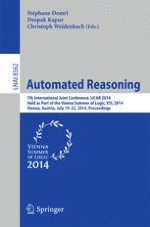This book constitutes the refereed proceedings of the 7th International Joint Conference on Automated Reasoning, IJCAR 2014, held as part of the Vienna Summer of Logic, VSL 2014, in Vienna, Austria, in July 2014. IJCAR 2014 was a merger of three leading events in automated reasoning, namely CADE (International Conference on Automated Deduction), FroCoS (International Symposium on Frontiers of Combining Systems) and TABLEAUX (International Conference on Automated Reasoning with Analytic Tableaux and Related Methods). The 26 revised full research papers and 11 system descriptions presented together with 3 invited talks were carefully reviewed and selected from 83 submissions. The papers have been organized in topical sections on HOL, SAT and QBF, SMT, equational reasoning, verification, proof theory, modal and temporal reasoning, SMT and SAT, modal logic, complexity, description logics and knowledge representation and reasoning.
